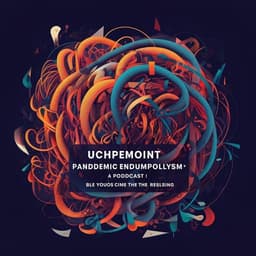
Business
Pressure, state and response: configurational analysis of organizational resilience in tourism businesses following the COVID-19 pandemic crisis
R. Zhao and L. Li
This fascinating study by Ruiyi Zhao and Ling Li explores the resilience of Chinese tourism companies during the trials of the COVID-19 pandemic. Utilizing innovative frameworks to dissect the dynamics of corporate governance and resource management, it uncovers vital insights that bolster sustainability in the tourism sector. Don't miss out on these compelling findings!
~3 min • Beginner • English
Introduction
Tourism, a highly competitive and crisis-prone industry, was severely disrupted by COVID-19. While many firms struggled, some recovered more quickly, prompting questions about what factors drive organizational resilience. The paper frames resilience development as a process using a PSR (Pressure-State-Response) perspective, embedding a resource–capability–relationship framework: epidemic pressure (external shock), firm state (corporate governance and redundant resources), and response (CSR). The study addresses three research questions: (RQ1) Which combinations of conditions can drive organizational resilience via different paths? (RQ2) Which conditions are more influential? (RQ3) Which conditions exhibit matching or substitution effects? Focusing on Chinese listed tourism firms—an appropriate context given China’s early, intense shock and recovery—the study applies fsQCA across 2018–2020 and complements with fixed-effects regressions (2010–2020) to identify mechanisms that foster resilience and assess the impact of epidemic changes on resilience configurations.
Literature Review
Organizational resilience—defined as an organization’s ability to recover to its initial state after shocks—has been studied through three main lenses: resources, capabilities, and relationships. Resource-based work highlights redundant resources (unabsorbed, absorbed, potential) as buffers (e.g., cash holdings), though findings on absorbed redundancy are mixed and effects may depend on allocation capabilities. Capability-focused research emphasizes dynamic capabilities and leadership/governance practices as drivers of resilience; corporate governance can shape CSR and crisis responses but its direct role in resilience has been underexplored. Relationship-based research, grounded in stakeholder theory, views CSR and social capital as enhancing resilience by fostering trust, legitimacy, and access to scarce resources. Gaps remain: limited integration across perspectives; predominance of net-effect methods over configurational analysis; insufficient inclusion of external shocks in holistic frameworks; scant examination of interactions (complementarity/substitution) among antecedents; and underrepresentation of developing-country evidence.
Methodology
Design: A PSRO framework embeds the resource–capability–relationship paradigm into the PSR process: Pressure (P) = epidemic intensity; State (S) = corporate governance and redundant resources; Response (R) = CSR; Outcome (O) = organizational resilience. The study applies fuzzy-set Qualitative Comparative Analysis (fsQCA) for configurational effects and a time fixed-effects regression for robustness.
Sample and data: 35 Chinese listed tourism and airline firms selected via multi-step screening (industry directories, business scope dominance, exclusion of financially distressed ST/PT/*ST firms, and listing year) yielding 29 tourism and 6 aviation firms. Primary period for outcome measurement: FY2020 with a 90-day window after 31 Dec 2019 (initial COVID-19 phase) to minimize market noise. Comparative fsQCA conducted for 2018–2020 (2018–2019 as no-epidemic baselines). Panel data for 2010–2020 used for regression robustness.
Measures:
- Outcome (Organizational resilience, Or): Annualized historical stock price volatility over the 90-day window; lower volatility indicates higher resilience.
- Pressure (Cc): Number of confirmed COVID-19 cases at the firm’s location (district-level for municipalities; city-level otherwise) over the window.
- State – Redundant resources: Unabsorbed redundancy (Us = current assets/current liabilities), Absorbed redundancy (As = administrative expenses/sales revenue), Potential redundancy (Ps = total liabilities/total assets minus industry median by sector).
- State – Corporate governance: Executive compensation (Sal = total compensation of top three executives, lagged two periods) and % independent directors (Ind, lagged two periods).
- Response (CSR): Hexun composite CSR score (five dimensions: shareholders, employees, suppliers/customers/consumers, environment, society), lagged one period.
fsQCA procedures: Calibration via 95th/50th/5th percentiles (full membership/crossover/nonmembership), with a special rule for Ind (crossover at 1/3 per CSRC). 0.001 added to avoid exact 0.5 memberships. Necessity analysis threshold 0.90; sufficiency analysis with appropriate truth-table frequency (1 for small/medium samples) and consistency thresholds (≥0.75 for solutions). Configurations derived for high and low resilience for each year (2018–2020). Robustness tested by raising consistency threshold (0.8→0.89).
Endogeneity handling: fsQCA does not address endogeneity directly; the study mitigates by lagging governance and CSR variables. For panel regressions, a year fixed-effects model (2010–2020) is used; governance variables lagged two periods, CSR lagged one period. Alternative epidemic event windows tested for robustness.
Key Findings
- No single necessary condition: Across 2018–2020, no antecedent exhibited necessity (consistency < 0.9), indicating resilience arises from combinations of conditions.
- Four high-resilience configuration patterns (2018–2020):
1) Under epidemic pressure: Redundant resource deficit with high executive pay incentives (core) and low potential redundancy (low leverage) → resilience even when CSR is weak and absorbed resources are low; independent directors often present as marginal supports.
2) Low epidemic pressure, low financial risk, CSR-driven: When epidemic pressure is low and potential redundancy is low, active CSR (core) yields high resilience; governance conditions are marginal.
3) Resource deployment with CSR under low financial risk: High absorbed redundancy (core), low potential redundancy (core), and strong CSR (core) jointly drive resilience; unabsorbed redundancy and pay incentives vary across equivalent configurations.
4) CSR under low financial risk: In non-epidemic years (2018), low potential redundancy and high CSR (both core) suffice for high resilience; absorbed redundancy importance varies by year and accompanying conditions.
- Role salience:
- CSR as a core driver: Appears as a core presence across high-resilience configurations, underscoring stakeholder relationships and social capital for resilience.
- Corporate governance in crises: Under high epidemic stress (2020), executive compensation becomes core, with independent directors as effective marginal overseers; governance compensates for deficits in resources/relationships.
- Redundant resources: Unabsorbed and absorbed redundancies act as buffers and, under certain endowments, can substitute for weaker CSR or governance; potential redundancy (higher leverage) consistently appears as a core missing condition in high-resilience configurations.
- Low-resilience configurations (2018–2020): High potential redundancy (implying elevated financial risk) frequently appears as a core presence, and resilience remains low even when other resources (unabsorbed/absorbed) or governance pay are present; CSR alone is insufficient when redundancy structure is weak or financial risk is high.
- Substitution/complementarity: Evidence of substitution effects where unabsorbed redundancy can substitute for CSR, executive compensation, or absorbed redundancy; absorbed redundancy can substitute for independent directors or unabsorbed redundancy, depending on context.
- Regression robustness (2010–2020, year fixed effects):
- Independent directors (lagged) associated with improved resilience (lower volatility; significant at 10%).
- Executive compensation (lagged) positive but not significant overall; stronger in crisis configurations (fsQCA).
- Absorbed redundancy associated with improved resilience (significant at 1%).
- Potential redundancy (leverage) associated with worse resilience (significant at 5%).
- CSR (lagged) associated with improved resilience (significant at 1%). Results robust to alternative event windows and show acceptable multicollinearity (VIF ~1.1–1.6).
Discussion
Findings address RQ1–RQ3 by showing that resilience emerges from multiple, equifinal configurations that combine external pressure, internal states, and responses. CSR consistently acts as a core relational mechanism that builds legitimacy and social capital, enabling faster stabilization and recovery. Under severe epidemic pressure, governance capabilities—especially incentive-aligned executive leadership—become decisive and can compensate for deficits in resources or weaker CSR, aligning with dynamic capability views. Resource structures matter: unabsorbed and absorbed redundancies buffer shocks and can substitute for some governance or relational weaknesses, but high potential redundancy (financial leverage) undermines resilience, overshadowing other positives. These results highlight a blended efficiency–legitimacy mechanism: resource efficiency (redundant resources) and legitimacy seeking (CSR) are complementary rather than exclusive, and their balance determines resilience under varying epidemic conditions. The configurational approach clarifies why prior net-effect studies report mixed findings and emphasizes managerial levers that vary across crisis/non-crisis contexts.
Conclusion
The study develops a PSRO framework integrating resource–capability–relationship antecedents into the PSR process and, using fsQCA on 35 Chinese listed tourism firms (2018–2020) with regression robustness (2010–2020), reveals: (1) No single necessary condition for high resilience; (2) Four equifinal high-resilience configurations featuring CSR as a persistent core driver and governance (executive pay, independent directors) as particularly impactful under high epidemic pressure; (3) Substitution/complementarity among resources, capabilities, and relationships—unabsorbed and absorbed redundancies can, under certain endowments, substitute for weaker governance or CSR; (4) High potential redundancy (leverage/financial risk) is central in low-resilience configurations, and CSR alone cannot overcome adverse resource structures. The work contributes a process-oriented, configurational understanding of tourism organizational resilience and offers actionable insights on aligning governance, resource buffers, and CSR for crisis preparedness and recovery. Future research should expand contexts, refine resilience measures and time windows, and apply dynamic QCA to capture temporal evolution.
Limitations
- Methodological: fsQCA cannot fully address endogeneity (reverse causality, omitted variables); mitigation via lagging variables is incomplete.
- Contextual: Evidence from Chinese listed tourism firms may limit generalizability due to institutional and cultural specificities and a relatively small case set.
- Measurement: Resilience proxied by 90-day stock volatility may not capture longer-term or operational resilience; reliance on market-based measures may introduce bias.
- Dynamics: While configurations are compared across 2018–2020, dynamic changes in antecedents over time are not modeled; time-series QCA developments are needed for process tracing.
Related Publications
Explore these studies to deepen your understanding of the subject.







